Why scales are [not] important
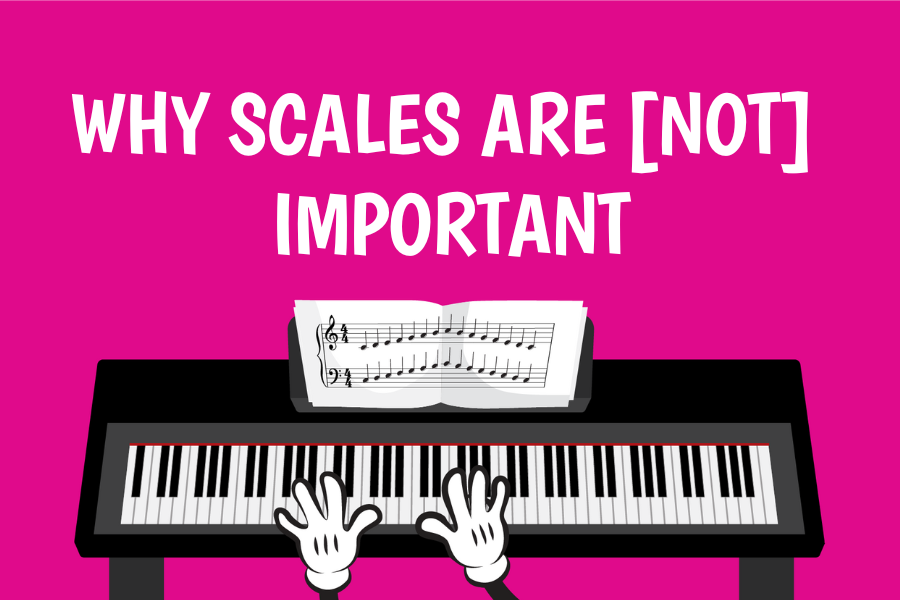
Warning: this post contains some thoughts on why students might not need to play scales. This content may be distressing to some readers. 😊
In the middle of 2023, I had an epiphany: I realised that I really needed to get my students playing some scales.
You might be thinking, what sort of [insert derogatory word here] piano teacher doesn’t have their students playing scales? What on earth was I doing up until 2023?
It wasn’t always like this.
I used to have all of my students doing exams and diligently learning their technical work, just like I did when I was a student, going through all the AMEB grades. In my early days of teaching, I never questioned that C major is the very first scale we learn/teach. Later, with more experience, I would tell my students that C major is the most difficult scale, and no-one would believe me until they got to Grade 71.
But now, none of my students do exams. That’s right – none. It has taken many years of weaning2 and convincing3 but now I have a studio in which we delight in the joys of piano playing without ever having to:
- limit repertoire choices to certain lists
- dig down into technical work that has no relevance to the current repertoire
- ignore non-examinable activities like improvisation and composing
- keep playing a piece way beyond its use-by date
… all because of an upcoming exam.
It has been a journey, but that’s for another blog post. In the meantime, back to the scales thing.
In my opinion, it’s not important to play scales just for the sake of it. If a new adult student comes to me wanting to play a certain Bob Dylan chord chart, I do not insist that their musical journey starts off with learning scales4. If a teenager is just barely hanging on to piano, but they are loving improvising and perhaps learning just one contemporary piece, I am not going to insist they spend any of their precious practice time on scales or arpeggios.
But if there are scale passages in the piece they are learning, that’s a great time to focus in on the scales of those keys and their relatives, in different rhythms and dynamics and registers. Same with arpeggios, or passages of octaves. The repertoire will always give us opportunities to practice technical work.
However, with beginner and intermediate repertoire, particularly based on the contemporary aural palette of the 21st century, there are often no such passages. And gradually, I found that because I was specializing in the early intermediate level, I had stopped asking my students to practice scales, because we just weren’t coming across them in the repertoire.5
This meant that my students were lacking an important part of musical development. Scales and arpeggios are all about KEYS and keys are super important! Having a basic knowledge of the structure of scales/arpeggios/keys is fundamental, for reasons such as:
- Finger Gymnastics: Scales and arpeggios are like a workout for your fingers, in predictable patterns.
- Finger Freedom: Playing technical work teaches your fingers and arms (and torso!) to MOVE.
- Music Theory 101: Even if modern music isn’t all about major and minor scales, knowing scales helps you understand the basics of music theory.
- Sight-Reading Superpowers: Practicing scales makes sight-reading easier. Recognising patterns and applying fingerings in a certain key means being able to learn piece faster.
- Improv Magic: Scales and modes are the secret sauce for improvisation. They give you a set of notes to play around with, so you can create your own melodies and harmonies on the spot.
- Ear Training: Scales and modes teach us how to HEAR, and give us the basics of the Western tonal tradition.
So… how to get my students interested in playing scales, when there’s no exam syllabus or deadline?
This is how I came up with…
The Circle of 5ths Challenge
I decided that every student, from about late elementary onwards, would participate in the Circle of 5ths Challenge. The idea would be to complete a series of activities in every key, over a period of however-long-it-took. Here is the sheet I designed:
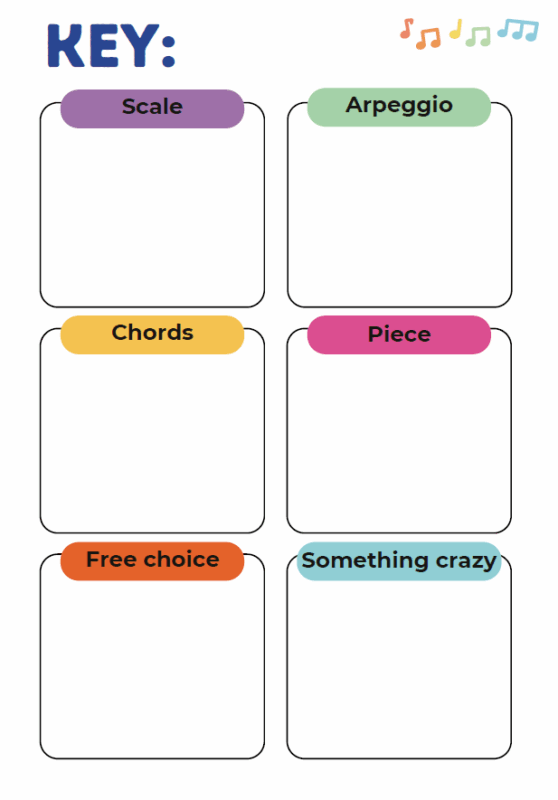
I sent this design off to a printing company and got A4 notepads with 50 sheets each! I had intended to give each student their own notepad but in the end it was easier to just give individual sheets.6
The idea is that students have to complete each box in whatever the designated key is, by playing something appropriate to their age and ability. This is different for everyone! Playing a scale or arpeggio does not have to be a four-octave-hands-together extravaganza. It can be just one octave ascending with a single finger playing each note. The point is to know how it sounds, and that it represents a key.
The ‘free choice’ often ends up being an improvisation or composition, or sight reading in that key (the ‘Smart Scales’ duets by Diane Hidy are awesome for this), and the ‘something crazy’ is meant to be a crazy way of playing a scale or arpeggio, e.g. one hand legato the other hand staccato, or with eyes closed, or doubling every second note – or whatever they think is crazy!
For ‘piece’, I knew there was no way my mostly-intermediate students could tackle the Chopin Preludes or Bach’s 48 Preludes and Fugues. I decided to make sure I had a Rote Repertoire piece ready in every possible key, in case none of their intermediate repertoire complied. This meant I had to write quite a few new pieces, as I discovered that some keys like Bb major and F# minor were poorly represented! As of writing this blog I’ve got all but one key covered – email me if you want to know what key that is, and to see if I’ve managed to cover it yet 😊
I also discovered Juan Cabeza’s notebook of 24 Miniatures, charming little pieces which are very accessible and cover the pentascales in all 24 keys.
As a backup for ‘piece’ and also to help with ‘scale’, ‘arpgeggio’ and ‘chord’, I wrote a little exercise called ‘C major Essentials’ and then transposed it into every single major and minor key, and saved it as 30 different assignments in Vivid!7Here it is in E flat:
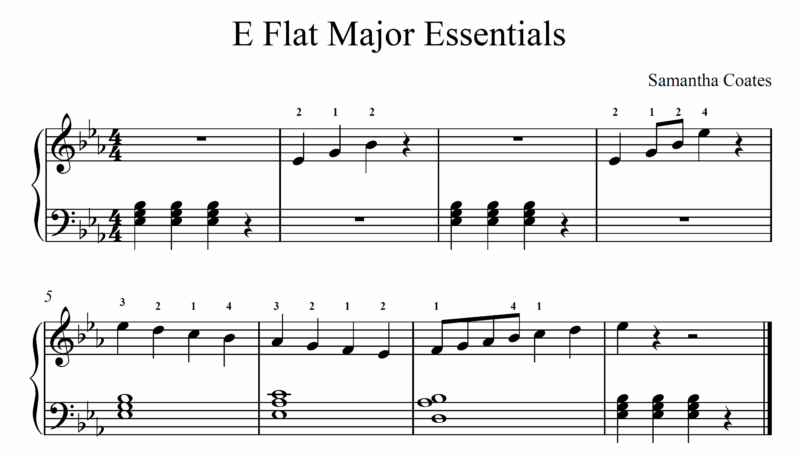
Having all the materials now ready to go, I wanted the process of choosing a key to be fun and a bit random. A while ago my graphic designer Jen had designed me a super colourful circle of 5ths. This is now on my wall as a magnet dartboard, and throwing a dart is a fantastic way for students to choose their next key!
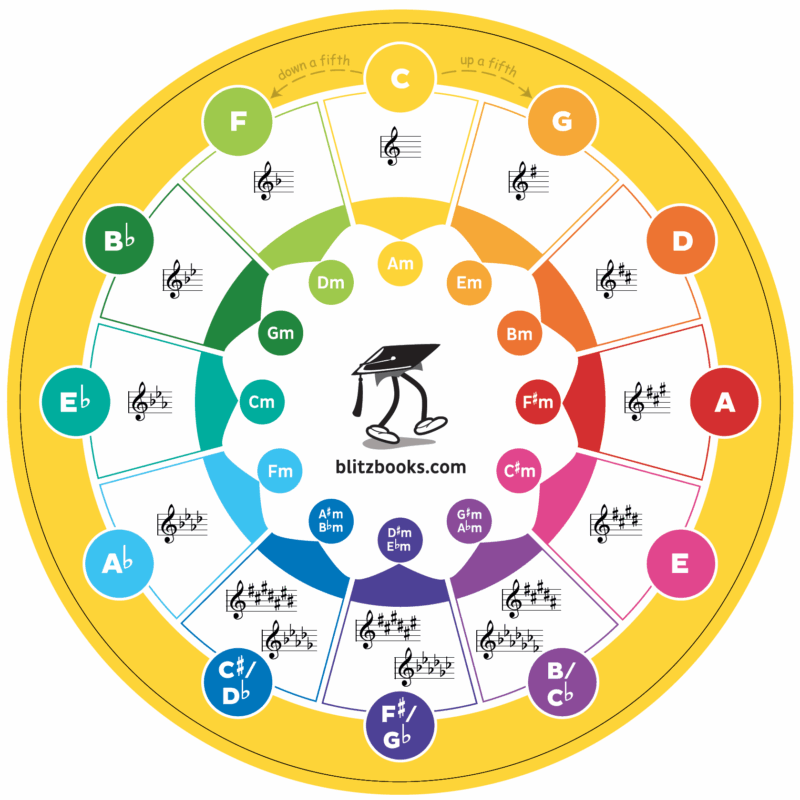
I then asked Jen to design me a colour-in version for students, so that they could keep track of which keys they had done:
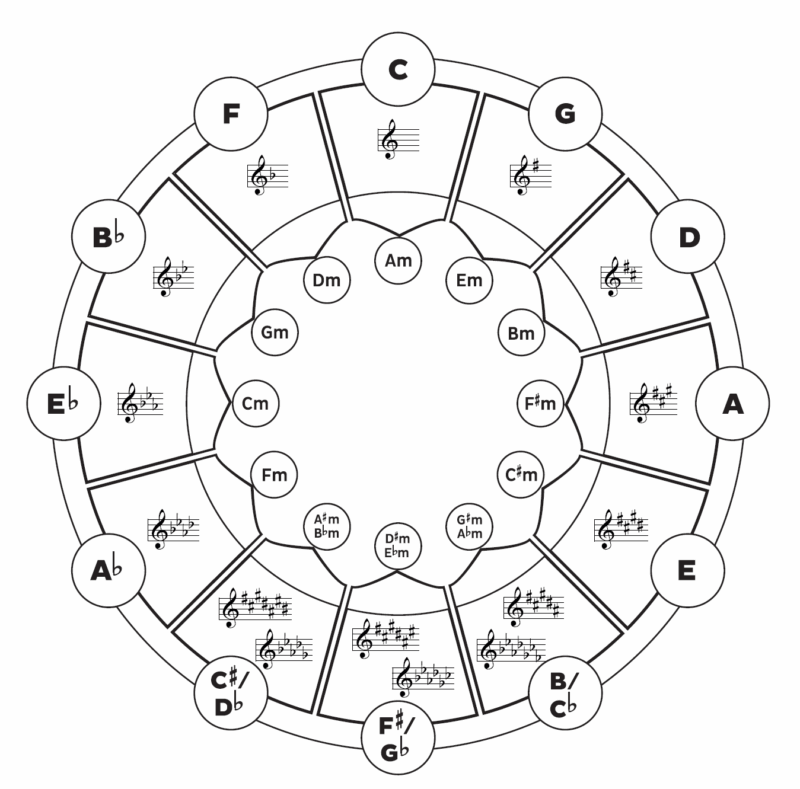
This challenge has been going for over a year now. This is what I wrote to students and parents in the newsletter at the beginning of 2024:
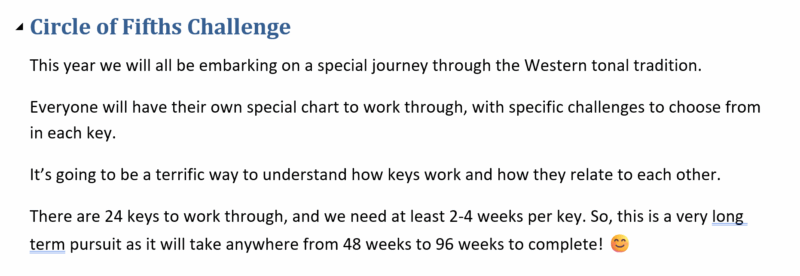
I am amazed at the speed of some students (and lack of speed of others!!!) who are just zooming through, eating up each key and as a result covering repertoire they would not normally have come across. Here are photos of the sheets of the two students who are furthest through the challenge:
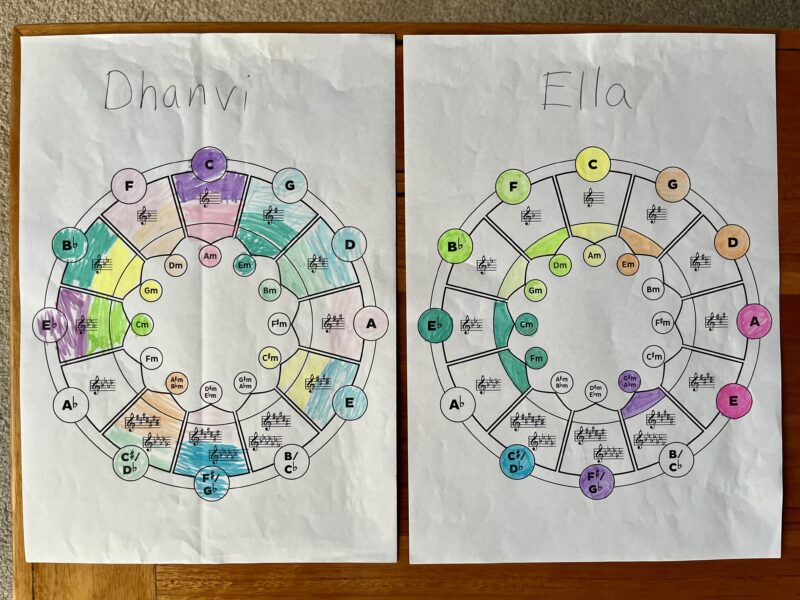
This whole thing has been such a validating experience for me as a teacher. I feel that all of my students, no matter how young, really understand what it is to be ‘in a key’. And the best part is that they are not complaining about practising scales – in fact they are always excited to choose their next key. 😊
- After finally having played all the black-note scales and realising how much easier they are!
- Both myself and my students
- Of parents and students
- They are usually pleasantly surprised and mightily relieved!
- I was hesitant to put scales on their practice tasks, because, let’s face it, scales and arpeggios are not very musically satisfying.
- As a result I had far too many of these so I gave away several notepads to teachers who attended the Pizza, Pinot and Pedagogy event last July.
- Why 30 and not 24? Because I included all the enharmonic keys.

Hi Samantha,
I use your books for my students. Some play piano piano, others, play strings, and most sing. I have been a music teacher for 53 years now, and I am surprised (and glad) that I am still at it!
On Saturdays (the highlight of my week) I take (conduct) the kids for orchestra. We have two of them; one those who have reached Grades 1 – 3, and one for those who are Grade 4 up. We hold concerts at the end of every term.
I have the kids playing all of the scales and arpeggios more as an ear training tool than an exam requirement. They improvise as well.
Here is what I do: (feel free to try it out yourself).
The system uses the alphabet. In this way, it does not matter what instrument you play you can all join in (think of an full orchestra or concert band). Everyone has their starting point to play together. Flutes on Bb, Clarinets of C, etc. Starting at their lowest point they proceed upwards, in the first instance, moving in a chromatic order, rather than in the cycle of 5ths, but they learn how to do that, too!
Here it is: (I will start on C – good for violists and cellists, G is good for violins – their lowest notes, A for pianists). We do not stop after one octave but keep moving until we run out of notes or stop at the tonic. That means that pianists get to play all of their notes very early on!
C D E F G A B C
C# D# E# F#G# A# B# C#
D E F# G A B C# D
Eb F G Ab Bb C D Eb, etc.
They play through every scale in ascending order only, chromatically. Of course, they can do likewise coming down. Their aural development is based on recognition of the scale or arpeggio structure. Some also enjoy making up their own pieces in various keys.
I developed this approach in my early 20s as I was looking for a better way to teach scales. I had come to realise that there are/were many professionals out there who did not know all of their scales (think dominant and diminished 7ths, whole tone scales, relative minors let alone all the majors). I was shocked. They could manage to work some of them out by ear, others had to really think about them, and others did not know their modes at all.
I made up a book containing all of the requirements for my students and even developed a simple formula for working out every scale or arpeggio after learning only the major scale. I am 73 years old now and still using it.
Sorry for the long letter. I still hold my passion for music!
Nice pic of you dancing with your son.
Cheers,
Jack
Thanks Jack, how fantastic that you came up with this resource!
Excellent ideas here, Samantha. I love your creativity & enthusiasm. I’m retired now with just a couple of students, but new.ways of teaching scales are always refreshing. Piece key/keys = scales to be learned is what I do now. Makes so much sense & a time saver too, as you said.
Keep smiling…
Thank you Priscilla!
Great work, Samantha! I love your Theory books❤️
Thanks Chris!
Thanks Sam, brilliant as always! I use scales sometimes for technique – ie to help with hand shape or legato. I do agree that one of the most important things with learning scales is that key recognition. I always do primary chords with each scale too. Thanks! 😀
Thanks Kate!
Hi Samantha!
Just woke up, read your fun blog and laughed at your wise and witty style of writing ❤️. Thanks for the nudge – I’m giving your challenge in my teaching practice a go!
That’s great to hear Berry! 🙂
Great idea Samantha! I love the Smart Scales and 24 miniatures too 🙂 Are the circle of firths resources you produced able to be purchased?
No, they are not commercially available, but email me if you want pdfs.
Oh…this will be a great way to kick off summer lessons. Thanks so much for the inspiration!
Yay! 🙂
I love this Samantha, this is exactly what I’ve been looking for – a comprehensive way to get students understanding keys that’s also fun! Do you have these challenge resources available for purchase?
Not for purchase, but if you email me I can send you a pdf of some things!
Hello, I’ve been reading your helpful content. May I kindly ask if I could also make use of the materials?
Please email me!